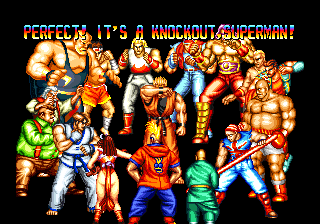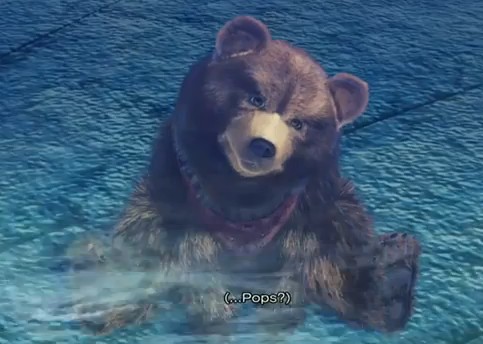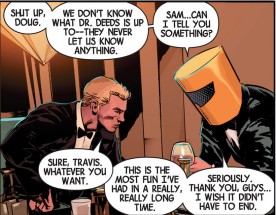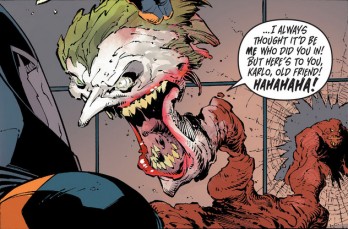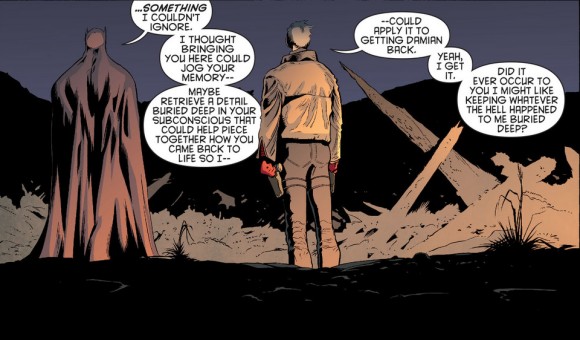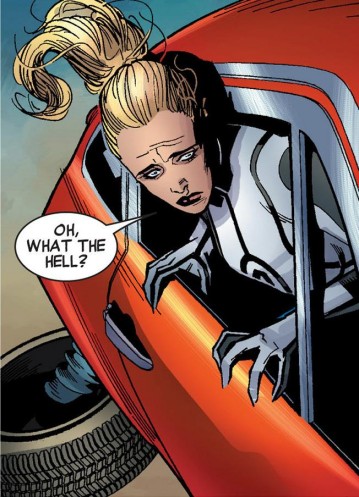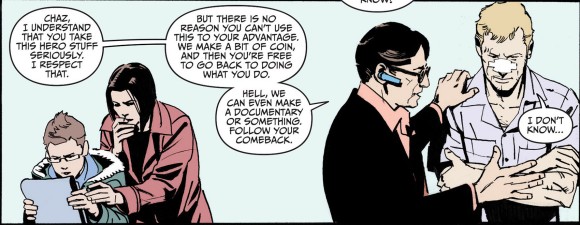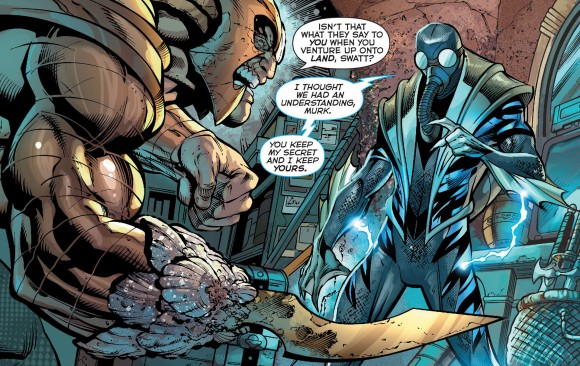
Bigger Than The Government: How We Look At Hip-Hop
May 17th, 2013 Posted by david brothers“Rap is the CNN of the streets.”
–Chuck D, more or less
Rap music is real.
We treat white people and white culture as the default culture in America. As a result, non-white voices are often marginalized and left out of the conversation. The various History Months and Pride Days — those are a way to correct our collective course and encourage the addition and recognition of other voices in our culture. It’s educational for outsiders and aspirational or inspirational for those who are a part of that culture.
In a lot of ways, rap music is like that. It’s an education. The art we create is a reflection of ourselves and the culture we live in. When dude from dead prez says, “The violence in me reflect the violence that surround me,” or when Kendrick Lamar says “I got the blunt in my mouth; usually I’m drug-free… but shit, I’m with the homies,” they’re speaking a truth. You are a product of your environment. You are influenced, and those influences are on display when you create something, whether that creation is your life or your art.
The violence, misogyny, and homophobia in rap are a reflection of the environments the rappers live in, from the crib to the block to the hood to the city to the state to the country. The joy, money-chasing, happiness, and pride in rap are a reflection of those same things, as well. The entire spectrum of content is a reflection, really.
When Chuck D said that rap music was the CNN of the streets — a statement repeated and remixed so often that I actually can’t figure out when or where he actually said it beyond “twenty years ago” — that’s what he was referring to. He was referring specifically to the way that rap lyrics reflect the lives of the rappers, and through the rappers, black people. Not all black people, obviously, but an important subset of the black community.
People say write what you know as advice to newbie writers, but the truth is that you can only write what you know. You’re drawing from your experience, be they direct or indirect. You’re spilling the contents of your brain, and in doing so, educating someone else.
Chuck D wasn’t saying that rap is non-fictional. He was saying that rap has non-fictional roots and that examining those roots is something that should be encouraged, not dismissed. Kanye rapping about trying to get a friend to hook him up with girls and that friend telling him to pump his brakes and drive slow — that’s real. 50 Cent saying that he’ll say anything to make his girl laugh, including “I love you like a fat kid loves cake” — that’s real. Killer Mike and NWA rapping about police brutality, Snoop and Kurupt slathering misogyny over funked out beats, Jean Grae kicking punchlines that make your head nod, Eminem talking about his relationship with his mother — those are all real, no matter how fictionalized they may be.
“Salt all in my wounds/ Hear my tears all in my tunes/ Let my life loose in this booth/ Just for you, muhfucker/ Hope y’all amused”
-Gunplay, 2012
Rap is real, but the meaning of real began to drift as time passed. Instead of representing the idea of emotional or intellectual honesty sitting inside a fictional construct, it began to mean something closer to “be a thug or else you’re fake.” “Keep it real” is a common refrain, or was at one point. It was the rallying cry for a certain type of rapper. Real in that sense meant a specific type of black masculinity and femininity. Real had been whittled down until it meant guns and drugs and bottles in the club. This happened for a variety of reasons — record labels love money, rappers love money, and it turns out white teens LOVE gutter raps — but it is what it is and we have to live with it.
A weird thing about rap is that it feels more “true” to me than most other genres. Part of it is the “CNN of the streets” aspect of things. I can hear myself and my experiences in Jay-Z, Nas, Weezy, and hundreds of other rappers. Kendrick Lamar talking about being lost, Joe Budden talking about awkward love, Killer Mike talking about anger, Devin the Dude talking about weed — I recognize and empathize.
Rap is real, but it’s fake at the same time. The line between the two is often blurred, as rappers draw from real life experiences, movies, other songs, and the rest of our culture to create their rhymes. Lupe Fiasco’s “Kick, Push” and “Kick, Push II” aren’t true stories, to my knowledge, but they are real. The same is true of Jay-Z’s “99 Problems,” which is partly real and partly fake.
Rap is real, but rap is fictional. But sometimes people get it twisted.
“They said I can’t rap about being broke no more… they ain’t say I can’t rap about coke no more!”
-Eminem, 2000
Earlier this year, Rick Ross kicked this rhyme on Rocko’s UOENO: “Put molly all in her champagne/ she ain’t even know it/ I took her home and enjoyed that/ she ain’t even know it.” It set off a firestorm of essays, complaints, and discussion. Eventually, Reebok dropped Ross from a sponsorship deal. The first petition I saw was this one, Lolia Etomi, though I think that this one was the biggest. Etomi’s petition has a passage that made my head turn:
If what he is saying is true, not just meaningless lyrics he has just publicly admitted to drugging and raping a woman. This should be investigated further and he should be prosecuted. If it is not true and they are just lyrics, he has still just glorified rape and this should not be ignored.
“If what he is saying is true.”
Rick Ross is an entertainer who has co-opted the identity of an infamous drug dealer. Put differently — Rick Ross is a liar. I don’t say that to be insulting, either. He’s a liar like Brad Pitt is a liar, like Denzel Washington is a liar. Brad Pitt has never beaten a man half to death for no reason and Denzel Washington was never Malcolm X. It’s obvious in movies. We know they’re fake. The idea of prosecuting someone in case their lyrics are true is laughable to me, but as I poked around, I realized that it actually happens. Which is a problem, and one that has its roots in the idea that rap is real.
Rap is fake, is the thing, but part of the mystique of rap is that you’re peeking in on another world that’s real to varying degrees. The verisimilitude of rap music blurs the line between real and fake. No one would think that Britney Spears actually did it again or that The Beatles lived everything they talked about, but it’s different with rap. Rap has “CNN of the streets” and “Keep it real” in its past, and that’s led to where we are today, when someone can honestly suspect that a rapper would actually brag about crimes they committed on a song geared toward being a smash hit and played nationwide. I figure how I feel about that is how heavy metal fans felt about the Satanism scares? It’s a possibility.
Keeping your Rap World believable and — maybe more importantly — profitable is tough. I was reading a Complex piece on Ghostface’s favorite songs and came across this:
“I even like ‘Spot Rusherz.’ Rae was saying some fly shit on there. And I was going in on the intro. But I remember when I said, ‘Yo Rae, come here,’ at the end, and he’s like, ‘Yo, chill Ghost.’ And I’m like, ‘Yo Rae, I’m ‘bout to scrape her.’ But I said ‘rape’ at first. ‘Yo Rae, I’m ‘bout to rape her.’ He was like, ‘Nah, we can’t say that.’ [Laughs.] It was too much. He said, ‘No, just say ‘scrape her.’’ And it became ‘scrape.’ I was just thinking about that the other day.
It stuck out to me because the standards for violence and rape in rap has been on my mind for a while now, but also because the implications are fascinating. Some artists have made careers while incorporating rape lyrics. Eminem’s “Who Knew”, for example, includes the lines “You want me to fix up lyrics while the President gets his dick sucked?/ Fuck that! Take drugs, rape sluts/ Make fun of gay clubs, men who wear make-up.” DMX told a faceless enemy that he’d rape his teenaged daughter and Biggie has friends who rape children and throw them off bridges.
At the same time, Eminem’s hit single “My Name Is” included the lines “Extraterrestrial, runnin’ over pedestrians/ in a spaceship while they screamin’ at me ‘Let’s just be friends!'” on the Slim Shady LP. On the original version, those lines were “Extra-terrestrial, killin’ pedestrians/ Rapin’ lesbians while they’re screamin’ at me, ‘Let’s just be friends!'”
Where’s the line for “too far”? Is there a line? Should there be a line? In the case of Rae and Ghost, an off-hand mention of rape was too far. The rest of Only Built 4 Cuban Linx… is about dealing drugs, mafioso aspirations, and how ill Clarks Wallabees are. The violence and other misogyny were acceptable, but a direct rape reference — in the song he makes a woman strip down to her Claibornes and then changes his mind — was not.
The line may be tied to fame. Before Slim Shady LP, Eminem was an underground emcee. He had cosigns from Dr Dre and Jimmy Iovine, but he wasn’t anybody yet. He was far from a household name. His first album was softened up — unevenly, if you know it well — probably for the sake of mass appeal. But his Marshall Mathers LP opens with a verse containing these lines:
“Oh, now he’s raping his own mother, abusing a whore, snorting coke, and we gave him the Rolling Stone cover?”
You god damn right, bitch, and now it’s too late
I’m triple platinum and tragedies happen in two states
In what is in hindsight a amazingly self-aware move, a skit on Eminem’s Marshall Mathers LP features a skit with Paul Rosenberg, co-founder of Eminem’s Shady Records. Paul, being the liaison between Em and Interscope, is in charge of making sure the ship runs smoothly and the album gets cleared for release. On the skit, Rosenberg says “Dre gave me a copy of the new album… and I just… [sigh] …fuck it.” It’s another essay, but I think Eminem might be one of the most self-aware/self-conscious rappers in recent memory.
By the time Marshall Mathers LP dropped, Eminem was a Name. He made his label millions, he was well on the way to making himself millions, and his videos probably played on MTV more often than he had hot meals. Being a Name brings a certain level of power. When you’re a young guy trying to take advantage of your big break, do you have to sand down your rough edges? But if you’ve already made that break, if you’re established and in a position to defend your art, are you more free to say whatever you want, as long as it’s in a creative context?
Necro, Ill Bill (as a solo artist), and Non-Phixion provide a counterpoint. They’re not going for major label sales or acceptance. They don’t care if somebody’s mama in Minnesota gets offended at their lyrics, so creating songs like “I Need Drugs” and “How to Kill A Cop,” both of which are flips of other popular rap songs, is no skin off their back. Their underground status gives them the same freedom that Eminem’s “made man” status awards him. If you’re not trying to be big, or if you’ve already made it, you have benefits people who haven’t made it yet don’t have.
(Biggie’s another case, one I haven’t quite figured out yet. But, off the top of my head, I have the feeling that he kept his really gutter material segregated from his R&B crossover lyrics. They were on the same album, but aimed at different audiences, much like Eminem’s emotional, violent, and pop songs were serving varied masters.)
Ross is a third situation. He got big, but made himself beholden to non-creative corporate interests at the same time. He became a spokesman for Reebok, as Reebok wanted to use his brand to extend their influence amongst men. The Ross brand is extravagant, suave, and wealthy. He’s selling a lifestyle. But, as pointed out by my friend Cheryl Lynn Eaton, one of Reebok’s primary audiences is women. So a rape line in raps doesn’t play. I spent a lot of time thinking about this aloud on tumblr a while back, and I was struck when a reader said that “It’s easy to feel like a protagonist, “I am the guy doing the rad violence and Whatever He Wants”, but when the power trip is date rape it gets REALLY hard for me to see myself as macho hero instead of ‘date-raped anonymous girl’.”
I was struck because it’s so plainly true. It’s one of the simplest explanations of the downsides of the One Man To Make Things Right scenario. When Ross said what he said, he immediately alienated a significant part of Reebok’s audience in a way that the drug raps and violence don’t, and was punished financially for it. He’s free to say whatever he wants, but free speech has a price.
“Music… reality… sometimes it’s hard to tell the difference. But we as entertainers have a responsibility to these kids… psyche!”
–Bizarre, 2002
The context between 2013 and 2000, when Eminem was blowing up, is different now, too. There was no Twitter, no Tumblr, no Facebook. Blogs weren’t what they are now. If you wanted to make a stink, you had to either get on TV, write a book, or get into a magazine. Nowadays? I can just type in “4thletter.net” and go buck wild with a three thousand word essay on how we view rap.
That changes the conversation. Voices that weren’t originally in that conversation are now free to join it, and have a platform that lets them explain their position in a detailed and well-reasoned manner. These voices often lack the legitimacy that’s awarded to people who use traditional channels, but Twitter has a way of turning small things into big ones. If you’re good, the tiniest blog can become the site of an enormous conversation.
You can see this change in conversation in the backlash against Ross, the discussion surrounding Chief Keef, the controversy about Lil Wayne using an Emmett Till metaphor, and the annoying conversations around Lana Del Rey’s “realness.” You can see it when Maura Johnston writes about how not to write about female musicians.
These new voices, like the Months and Days, serve as, if not a corrective, then something else to consider when creating your art or judging someone else’s art. I’ve personally been enriched by this. My thoughts about Ross were crystallized most through talking with white women who are mostly (as near as I can tell) outsiders to rap and black culture on Tumblr. Being around Cheryl Lynn for the past few years has shown me that some of the things I truly love treat black women like trash.
I like every part of rap. I can listen to Curren$y & Juvenile’s “Bitch Get Up” and Blu & Nia Andrews’s “My Sunshine” and recognize the pros and cons of both tracks. (Both of them go, personally.) That doesn’t make me a bad person or a hypocrite. There’s a time and place for everything, whether it’s Eminem’s “Kim” or Tupac’s “Dear Mama.”
(There’s something about how most of the controversy I’ve talked about has been specifically about misogyny or rape instead of violence, drug dealing, and everything else in rap, but I’d need a whole other uncomfortable essay to untangle that knot.)
When it comes to rap and reality, it’s like something David Simon once said. “We know more about human pride, purpose, and obsession from Moby-Dick than from any contemporaneous account of the Nantucket whaler that was actually struck and sunk by a whale in the nineteenth-century incident on which Melville based his book.”
In other words, if you want to know the human cost of the Vietnam War, you can google it and get numbers and data. If you want to know the emotional cost, you should listen to Freda Payne’s “Bring the Boys Home” instead. If you want to know the after-effects of Ronald Reagan’s tenure as president on the black community, read a book. If you want to know what catharsis and guilt sounds like, listen to Killer Mike’s “Reagan.”
Listen to rap.

